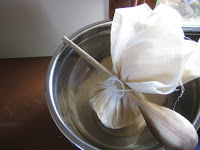The second cheese that I want to tell you about is simple like the soft yogurt cheese, but requires an additional product, a starter. I want to give you a little more knowledge in what a starter is in making homemade cheese or yogurt.
A starter is the first stage in cheese making and is to ripen the milk. In this process, milk sugar is converted into lactic acid. Cheese makers use starter cultures to control this ripening process or acidify the milk. This helps to start the process of separating the curds from the whey in which the curds will ultimately be cheese or yogurt. The same cultures are used for cow’s, goat’s and sheep’s milk.
For most a starter can also be accomplished using Kefir grains which is not yet in the mainstream, so the next best starter to purchase is a Mesophillic Starter. These starters are not very expensive, about $6. for a 5 pack. Starters keep for a long time, up to two years, in the freezer so your investment will not be wasted. Mesophilic starter is used to make low temperature cheese where the dairy is never heated above 104 degrees. This starter is also used in many other types of cheese, including Farmhouse Cheddar, Gouda, Cottage Cheese and a few other cheese recipes that I will post as I make them.
Now that you have your starter the recipe is simple to make.
This particular Cream Cheese recipe comes from the “Home Cheese Making“. It is the “uncooked method” and will result in a lighter/fluffier cream cheese.
Cream Cheese
1/2 gallon pasteurized Half and Half (do not use ultrapasteurized)
1 packet Mesophilic starter
Bring the half and half to room temperature. You are looking for a temperature of 72degrees. You can use a thermometer to check the temperature in the carton. If your house is not warm enough heat a pot on the stove empty for a two minutes just enough so that you can still touch the outside of the pot without burning yourself. Pour the half and half into the pot and check the temperature. I had to heat the pot with the half and half in the pot for another minute to get to the right temperature. If the dairy is at 72 degrees add the mesophilic starter, let the powder lay on the top of the half and half for two minutes then stir in thoroughly.
Cover the pot and set on a large towel and wrap the pot with the towel to keep in the heat. Leave it alone at room temperature for 12 hours. A solid curd will form. This type of cheese will not have a thick amount of whey, more of a thick solid curd. If your home is colder and the solid curd did not form after 12 hours let it sit up a few more hours. To tell when the set is right, it should be the consistency of a firm yogurt. Use a knife and gently cut into the curd to see if its a solid mass.
Once to the solid state the rest is the same as a soft cheese which is completed by hanging the curds in a t-shirt or butter muslin so that the whey will drip away from the solids. For canners this again is like hanging a jelly bag. Muslin fabric (butter muslin) is porous and great because you can wash the fabric and use it over and over. A clean pillowcase or t-shirt though will work in a pinch. (18 – 24 inch square)
Rinse out the cloth well, then line a bowl with the fabric, t-shirt or cheesecloth. If you are using cheesecloth fold it over itself if the weave is not tight to make a double layer if necessary. Slowly spoon the solid curd into the cloth. There are many ways to tie it, but the two most popular are bring three of the four corners together to hold the cheese. With the fourth corner, wrap it round the other three, and form a top-knot. The other is to bring all the corners together and tie them with twine. Wrap around a rolling pin or spoon handle and the whey will begin to drain and the curds remaining in the bag will thicken and until it turns to cream cheese.
 |
| Photo from theinvisiblecookbook.wordpress.com |
The process does take some time, about 24 hours, so find a good place to hang it just leave a bowl underneath to catch the dripping whey. Don’t leave your cheese to hang in the fridge: it will taste like pickles and bacon and kale or whatever is in there.
After 24 hours you’ll open the bag to find your cream cheese. It should be light almost like a whipped cream cheese. It can be eaten right away. You can mix in a teaspoon or so of salt or now it can be flavored. The cream cheese will last two weeks in the refrigerator in a tightly seal container. You can also press the cheese into a mold and rap in cheese paper. I use ball jars since I know they are good and tight. Once in the refrigerator the cream cheese will become firmer but still spreadable.








Leave a Reply